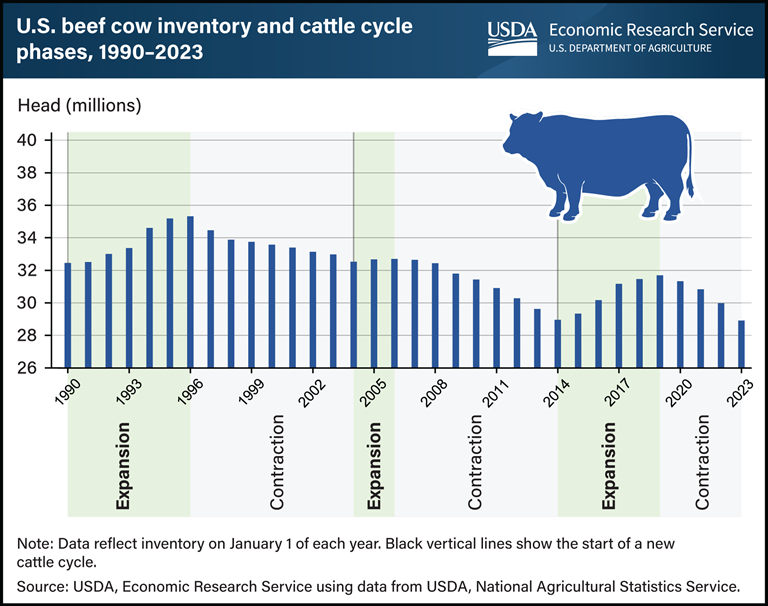Changes in beef cow inventory are related to the phases of the cattle cycle—the expansion (increase) and contraction (decrease) of the U.S. beef cattle herd over time. This cycle evolves gradually and tends to span 8 to 12 years. The cyclical pattern follows the biological nature of beef cattle production and cattle producers’ responses to changes in prices and climate conditions.
The current cattle cycle, which began in 2014, is now in a contraction phase, with inventory contracting at an increasing rate each year since 2020. On January 1, 2023, U.S. beef cow inventory was 28.9 million head, 3.6 percent less than the previous year. Drought is a significant contributor to recent declines in beef cow inventory, in part because of the detrimental effects of dry weather patterns on pasture and range conditions.
At the start of 2023, nearly 93 percent of U.S. beef cows were in States where most of the pasture and range were rated in “very poor” to “fair” condition based on data from the USDA, National Agricultural Statistics Service (NASS). Cattle producers periodically provide supplemental feed, such as hay, to maintain animals when pasture conditions are poor.
According to NASS, producers faced record-high prices of non-alfalfa hay during the last two quarters of 2022 and in each month through the beginning of 2023. High hay prices increase the cost of maintaining cattle and provide an incentive for producers to remove cattle from their herds. Except for one month in 2022, monthly beef cow slaughter has been higher year over year since March 2021. Meanwhile, beef cow inventory has settled at progressively lower levels since the 1990–2004 cattle cycle. This trend is consistent with the general decline in cattle inventories observed since 1975.
Effects of Drought on the Beef Cow Inventory
According to USDA-ERS, on Jan. 1, 2023, U.S. beef cow inventory was 28.9 million head – 3.6% less than the previous year.
Meanwhile, nearly 93% of U.S. beef cows were located in states where most of the pasture and range were rated in “very poor” to “fair” condition, based on USDA National Agricultural Statistics Service (NASS) data. Consequently, cattle producers faced record-high prices for non-alfalfa hay during the last two quarters of 2022 and in each month through the beginning of 2023, USDA-NASS reports.
As feed costs to maintain cattle continue to stress cattle producers’ bottom lines, a recent National Weather Service (NWS) forecast brings hope to some and more heartache to others.
The Season Drought Outlook, provided by the NWS Climate Prediction Center suggests drought is likely to persist in areas such as southeast Colorado and much of Kansas, Oklahoma and Texas, as these areas are so entrenched with drought that improvement will be difficult. The highest confidence for improvement exists across North Dakota, South Dakota, Nebraska, eastern Montana and Wyoming, the outlook adds.














